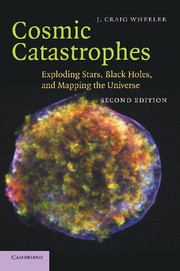Book contents
- Frontmatter
- Contents
- Preface
- 1 Setting the stage: star formation and hydrogen burning in single stars
- 2 Stellar death: the inexorable grip of gravity
- 3 Dancing with stars: binary stellar evolution
- 4 Accretion disks: flat stars
- 5 White dwarfs: quantum dots
- 6 Supernovae: stellar catastrophes
- 7 Supernova 1987A: lessons and enigmas
- 8 Neutron stars: atoms with attitude
- 9 Black holes in theory: into the abyss
- 10 Black holes in fact: exploring the reality
- 11 Gamma-ray bursts, black holes and the Universe: long, long ago and far, far away
- 12 Supernovae and the Universe
- 13 Wormholes and time machines: tunnels in space and time
- 14 Beyond: the frontiers
- Index
4 - Accretion disks: flat stars
Published online by Cambridge University Press: 14 September 2009
- Frontmatter
- Contents
- Preface
- 1 Setting the stage: star formation and hydrogen burning in single stars
- 2 Stellar death: the inexorable grip of gravity
- 3 Dancing with stars: binary stellar evolution
- 4 Accretion disks: flat stars
- 5 White dwarfs: quantum dots
- 6 Supernovae: stellar catastrophes
- 7 Supernova 1987A: lessons and enigmas
- 8 Neutron stars: atoms with attitude
- 9 Black holes in theory: into the abyss
- 10 Black holes in fact: exploring the reality
- 11 Gamma-ray bursts, black holes and the Universe: long, long ago and far, far away
- 12 Supernovae and the Universe
- 13 Wormholes and time machines: tunnels in space and time
- 14 Beyond: the frontiers
- Index
Summary
THE THIRD OBJECT
One of the major developments of mid-twentieth-century stellar astrophysics was the understanding that there is often a third “object” in a binary star system, especially in a system undergoing mass transfer. Matter from one star swirls around the other forming a configuration known as an accretion disk. Such disks were first recognized in the study of white dwarfs in binary systems. With the advent of X-ray astronomy, it became particularly clear that accretion disks play a prominent role in binary systems containing neutron stars and black holes. In many circumstances, the accretion disk is the primary source of visible light; in others, the disk is also the primary source of X-ray radiation and, in yet others, the disk channels matter into streams of outgoing material and energy. One dramatic fact is that, without accretion disks, we would not yet have discovered any stellar-mass black holes.
One star in a binary system must undergo mass transfer to feed the disk with the matter needed for the disk to exist at all. The disk forms around the star receiving the transferred mass. An accretion disk thus also depends on a more ordinary star (considering black holes to be “ordinary” in this context!) for the gravity to hold the disk together. Given this support from the two stars in the binary system – one to provide matter, one to provide gravity – the accretion disk then effectively has a life of its own.
- Type
- Chapter
- Information
- Cosmic CatastrophesExploding Stars, Black Holes, and Mapping the Universe, pp. 55 - 67Publisher: Cambridge University PressPrint publication year: 2007



